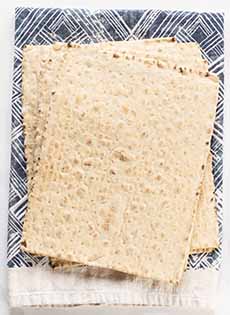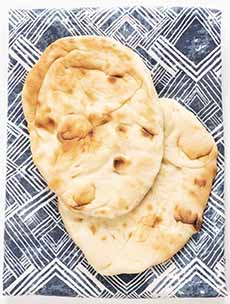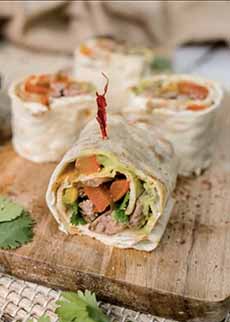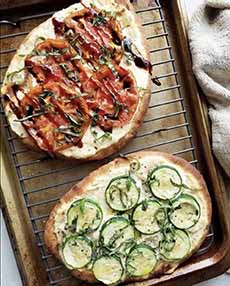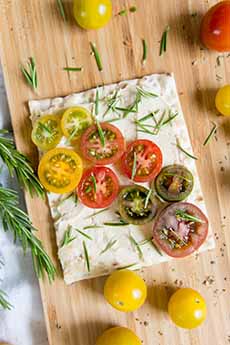TOP PICK OF THE WEEK: Atoria’s Family Bakery Flatbreads
|
We love bread, unashamedly. We’d rather eat bread than meat. We don’t need any condiment; just bread, delicious bread. Of course, that means good bread, artisan bread, bread from small bakeries like Atoria’s Family Bakery in Gilroy, California (they ship nationwide). Grandmother Atoria grew up in Assyria, the kingdom of northern Mesopotamia that became the center of one of the great empires of the ancient Middle East (it now comprises northern Iraq and southeastern Turkey). Atoria would watch her mother and grandmother bake flatbread in a rustic hearth oven, using their family lavash recipe. After migrating to America, where she was unable to find authentic lavash, Atoria started to bake her own. It wasn’t long before she decided to turn the bread of her youth into a business, and Atoria’s Family Bakery was born. Thirty years later, Atoria’s grandchildren manage the business, and produce three of the most popular flatbreads in the U.S.: The breads are cholesterol free, certified kosher by OU, and certified vegan. We love this line from the company’s website: “We don’t have time to take shortcuts.” It shows! We consume lots of flatbreads, and Atoria’s lavash, naan and pita are noticeably more flavorful than the brands available in our local markets. Depending on the type, flatbread may be unleavened, made from flour, water, and salt. Naan and pita recipes, traditionally do contain leavening, and Atoria’s pita includes it as well. Chapati, matzoh and Mexican tortillas, for example, are not leavened. Leavening adds flavor to the flatbread. Head to the website and order some of all three types of flatbreads. They freeze beautifully, although you’ll want to dig in the minute they arrive. Ready to roll? Here are Artoria’s tips to “wrap like a pro.” Check Out The Different Types Of Bread In Our Bread Glossary The earliest evidence of people using fire to cook food dates back some 75,000, among Neanderthals and Homo Sapiens. Man learned how to make between 1.7 to 2 million years ago. What remained was to discover that grains could be ground and mixed with water to create the first version of bread. Flour-and-water flatbreads, baked on a fire-heated rock or in embers from the fire, have been a staple for much of humanity for the past 5,000 years. The technique developed the world over. Commercial yeast, to make loaves of bread rise, was only isolated in the 1870s and marketed in 1876 (by the Fleischmann Brothers). Prior to then, bakers had to rely on wild yeast as it drifted through the air. When yeasts were captured, i.e. when dough began to rise, a piece of “starter” was retained to make the next loaf. Lavash is an ancient flatbread from the area of the South Caucasus (modern Armenia, Azerbaijan and Georgia), although it may have originated in what is modern Iran or Turkey. Evidence of lavash baking has been found dating to 3000 B.C.E. [source]. The word may derive from the Aramaic, “to knead.” While crispy lavash crackers may be the way in which many Americans have been introduced to lavash, the original is a soft, thin, large rectangle of flatbread, traditionally baked in a tandoor oven or on a terracotta griddle. While the earliest flatbreads were baked on hot rocks, when griddles were created* the breads had to be made thinner to fully cook through without burning. While different regions may vary the thickness, lavash is thin like a tortilla. When fresh, lavash is quite flexible and can be used for wrap sandwiches. But it dries out quickly and becomes brittle and hard. In Armenian villages, dried lavash is stacked up and can be rehydrated later (lavash has the longest shelf life of any bread—it can keep up to one year). The dried lavash is sprinkled with water to make it pliable again. The hard lavash can also broken into pieces and added to stew. Lavash is one of the most widespread types of bread in Armenia, Azerbaijan, Iran and Turkey [source]. Like food history? Check out more than 600 food histories on The Nibble, including: There are dozens of types of flatbread made around the world, with some listed below. (Here’s a full list.) Flatbread can be thick and soft like naan or thin and crispy like matzoh. It can be baked in an oven, fried in hot oil, grilled over hot coals, or cooked on a hot pan, tava, comal, or metal griddle. Also note that some of these flatbreads are used referred to as pancakes—but not the kind Americans eat for breakfast. Rather, they are used to scoop or food, wrap around food, or used as a base for a topping. Pancakes differ from flatbreads in that they made in a round shape; and in addition to water, flour and salt, pancake ingredients may include eggs, milk and butter. To illustrate the crossover between foods, naan flatbread is also made with milk and butter. There’s much more to learn about flatbreads. Stay tuned! |
|
|
|
|
||
